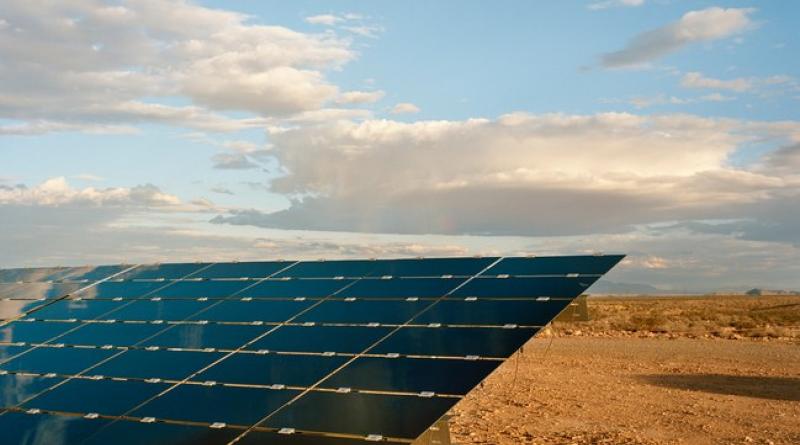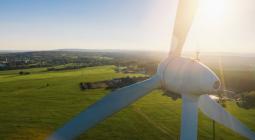The Good News About a Green New Deal.

Last month’s rollout of the Green New Deal, a fourteen-page legislative resolution, sponsored by Representative Alexandria Ocasio-Cortez and Senator Ed Markey, that called for “net-zero greenhouse gas emissions” through a ten-year “national mobilization,” has sparked a good deal of controversy. The resolution was larded with goals not directly tied to the environment, such as guaranteeing everyone a job, affordable housing, and high-quality health care, and even some energy researchers who are enthusiastic proponents of transitioning rapidly to a zero-emissions economy questioned the timetable of a single decade for converting power production entirely to renewable sources.
“I don’t think anybody who is deep inside the substance is talking about that,” Jonathan Koomey, a special adviser to the chief scientist at the Rocky Mountain Institute, told me. Robert Pollin, a professor of economics at the University of Massachusetts, Amherst, who has helped design a number of Green New Deals for individual states, including New York and Washington, said, “I think it is wonderful that the issue is being addressed, but I don’t think this movement has yet accepted that you have to do these things carefully and rigorously.”
Despite these reservations, Koomey and Pollin, as well as a number of other researchers I spoke with, said the drafters of the Green New Deal were perfectly right to urge large-scale action across many parts of the economy, and they emphasized the technological opportunities that now exist to meet many of the environmental goals that underpin the proposed legislation, if not the exact timetable it lays down. In a report released in October, which the Democratic resolution cites and endorses, the United Nations Intergovernmental Panel on Climate Change said that if the world is to contain the rise in global temperatures to 1.5 degrees Celsius, carbon emissions must be reduced by about fifty per cent before 2030, and completely phased out before 2050. For a U.S. economy that currently relies on fossil fuels for about four-fifths of its energy, achieving zero emissions, or something close to it, by the middle of the century would be a historic transformation. And, according to all the researchers I spoke with, rapidly advancing technology and the falling costs of clean energy make this more achievable than ever.
“Right now, we have about ninety per cent or ninety-five per cent of the technology we need,” Mark Jacobson, a professor of civil and environmental engineering at Stanford, told me. In a series of papers, Jacobson and his colleagues have laid out “roadmaps” to a zero-emissions economy for fifty states, fifty-three towns and cities, and a hundred and thirty-eight other countries, with a completion date of 2050. Just as in the Democrats’ Green New Deal, the central element of these roadmaps (and others) is converting the electric grid to clean energy by shutting down power stations that rely on fossil fuels and making some very large investments in wind, solar, hydroelectric, and geothermal facilities. Jacobson said this could be completed by 2035, which is only five years beyond the target set out in the Green New Deal. At the same time, policymakers would introduce a range of measures to promote energy efficiency, and electrify other sectors of the economy that now rely heavily on burning carbon, such as road and rail transport, home heating, and industrial heating. “We don’t need a technological miracle to solve this problem,” Jacobson reiterated. “‘The bottom line is we just need to deploy, deploy, deploy.”
Saul Griffith, a materials scientist and inventor who is the chief executive of OtherLab, a San Francisco-based technology incubator that focusses on clean energy, agrees. In recent presentations, Griffith has sketched out an aggressive plan for switching to clean power and electrifying heating and transportation, which he says could be completed within twenty years. “It’s entirely reasonable to do it,” he said. “The United States is lucky because of its natural advantages. It’s a country with low population density, good wind, good solar, and good hydro resources. The only reason not to do it is political inertia and the influence of the existing fossil-fuel industry.”
Pollin is working on a national zero-emissions plan with an end date of 2050. He said it will combine many of the elements in the Green New Deal, such as stricter emissions standards, extensive public investments, and tax incentives for reducing carbon consumption and investing in clean energy. And, like the Democratic proposal, Pollin stresses the need to provide financial aid and retraining for people currently working in fossil-fuel industries, which would be shrunken drastically under any such plan. “It needs to be done, and it can be done,” he said. “But it needs to be done judiciously.”
Underlying a lot of the optimism is a steep fall in the cost of generating electricity from renewable sources. With the development of bigger wind turbines, the cost reductions associated with wind power have been particularly impressive. Mara Prentiss, a professor of physics at Harvard whose book “Energy Revolution,” from 2015, emphasized the potential of renewable energy, pointed out to me that doubling the diameter of a turbine yields four times as much power, and that some modern turbines have diameters of a hundred metres. Costs have also fallen sharply in the solar-power industry, where there has been great progress in building more cost-efficient photovoltaic systems, including solar cells, inverters, and transformers. Just a decade ago, Pollin pointed out, electricity generated from sunlight cost about twice as much as electricity generated from coal; now, the costs are roughly equal.
Every year, the U.S. Energy Information Administration calculates a levelized cost of electricity, or L.C.O.E., which represents the average per-megawatt-hour cost of building and operating a power-generating plant over the course of its life cycle. For power facilities that would enter service in 2023, the E.I.A. estimated the L.C.O.E.s of onshore wind and solar at $42.80 and $48.80, respectively, compared with $40.20 for advanced natural-gas power stations. (The L.C.O.E. of nuclear would be around ninety dollars). Some existing coal-fired plants are cheaper, but they are also very dirty. In calculating the future cost of electricity generated from coal, the E.I.A. assumes that new coal-fired plants would be built with sophisticated systems to capture and sequester carbon emissions. Allowing for this requirement, the E.I.A. estimates the L.C.O.E. of coal-powered plants entering service in 2023 at close to a hundred dollars.
These figures suggest that, going forward, electricity generated from renewable sources will be competitive with natural gas, and cheaper than coal and nuclear power. (And these figures don’t take into account the existing tax credits for investing in clean energy. When these credits are included, the L.C.O.E.s of onshore wind and solar are even lower: $36.60 and $37.60, respectively.) In some parts of the country, energy consumers are already benefitting from these trends. Prentiss pointed out to me that Iowa now generates more than thirty-five per cent of its electricity from wind. The retail cost of electricity in the state is 8.73 cents per kilowatt-hour, she said, compared to a national average of 10.48 cents.
Iowa, of course, is a windy state. People need electricity all the time, regardless of the weather. For this reason, among others, the E.I.A. analysis pointed out that care should be taken in comparing the costs of different types of power. Defenders of fossil fuels go further. In a recent article about the Green New Deal, Myron Ebell, an analyst at the Washington-based Competitive Enterprise Institute, which receives some of its funding from oil and gas companies, wrote that the electricity grid “cannot operate on 100% intermittent and variable power—or even 50%.”
Optimists like Jacobson and Prentiss didn’t deny the challenge in shifting to intermittent sources of power, which include dealing with seasonal variability and storing energy for long periods. But they point out that the development of modern grids, which use high-voltage direct-current lines, has made these issues easier to handle. In a series of papers, Jacobson and his colleagues have used simulations to demonstrate how it would be possible in theory to rely entirely on electricity generated from renewable sources. “If you interconnect over a very large area, you smooth out the supply,” Jacobson explained. “When the wind is not blowing in one place, it is in another. And solar and other sources, such as hydro and geothermal, complement that, too.”
Koomey said researchers generally agree that getting to eighty-per-cent reliance on renewable sources of electricity is now a practical option. “The issue is more getting from eighty to one hundred,” he said. “I don’t know yet if one hundred per cent is possible. What I do know is that the cost trends are heading in that direction. And if we can solve the problems like seasonal heat storage, we can deal with most of the remaining challenges.” When I asked Koomey about the skeptics, such as Ebell, he replied, “The folks who are saying you can’t get to fifty-per-cent or eighty-per-cent intermittency are the same folks who were saying you can’t get to two per cent when wind and solar first came on.”
To guarantee a reliable electricity supply, Koomey suggested keeping some nuclear and natural-gas plants running, at least during the transition. (The Green New Deal rules out gas plants but doesn’t rule out keeping some existing nuclear plants running for a time.) But rather than focussing on the challenges of going all the way to a hundred per cent, the most important thing is to recognize the scale of the transformation necessary and get started on it immediately, Koomey insisted. “So far, all the tweaking around the edges hasn’t reduced carbon emissions nearly enough,” he said. “You need to start shutting down high-carbon infrastructure on a schedule, and you need to stop building new carbon infrastructure. Ultimately, there is no other way.”
Even if we did succeed in creating an electricity grid entirely powered by renewable energy, getting to zero carbon emissions for the over-all economy would involve overcoming some tough problems, such as finding practical ways to store large amounts of energy for longer periods of time, and weaning long-distance air travel and commercial shipping from the fossil fuels on which they now rely. (Jacobson and Prentiss insisted that there are technological fixes on the way in these areas, too, such as the development of better lithium batteries, and advanced hydrogen fuel cells; Prentiss also emphasized the possibilities of low-carbon biofuels and synthetic fuels.) In a recent article, Pollin argued that large-scale investments in energy efficiency, such as retrofitting buildings and switching to electric car engines, which waste a lot less energy than internal-combustion engines, “can cut U.S. per capita energy consumption by roughly 50 percent over twenty years.” Even then, though, the investments needed in wind and solar would be very substantial. In “Energy Revolution,” Prentiss calculated that satisfying the country’s total average energy needs with wind power would require covering about fifteen per cent of the U.S. landmass with wind farms, and relying entirely on solar power would require about one to 1.5 per cent of the landmass to be devoted to solar farms. Not for nothing does the Green New Deal resolution talk of a Second World War-style mobilization.
To illustrate how such a clean-energy economy might work, Jacobson brought up his own home on the Stanford campus, which has solar panels on the roof, two lithium batteries in the garage, and an advanced electric heat pump. “I have no gas or oil bills, no electricity bill, and no gasoline bill for cars, either,” Jacobson said. “And I generate twenty per cent more energy than I need, so I get paid five hundred dollars by the utility.” Jacobson estimated the up-front cost of equipping his house was about sixty thousand dollars. “With the subsidies that the government provides, it is a five-year payback,” he said. “Without the subsidies, it would be a ten-year payback.”
How much would it cost to create a national version of Jacobson’s domestic economy? There are at least two ways to answer this question. The first is to look at up-front capital costs. The other is to consider long-term trends in energy costs, and to consider the large-scale social and economic dislocation that may result if we don’t drastically reduce carbon emissions.
According to Jacobson, his plan to convert the United States to clean energy would cost between ten trillion and fifteen trillion dollars, in total, depending on how it was implemented. If the plan was enacted over thirty years, that would come out to as much as five hundred billion dollars a year, or about 2.5 per cent of current G.D.P. Pollin’s estimates are a bit higher. To meet the I.P.C.C. emissions targets, he reckons that wealthy countries such as the United States need to invest about three per cent of current G.D.P. per year expanding renewable sources and raising energy-efficiency standards, compared to the current figure of 0.5 per cent.
Interestingly, a new analysis of the Democrats’ Green New Deal from the conservative American Action Forum contains figures that are comparable to Jacobson’s and Pollin’s. Taking the midpoints of its estimates, the study says it would cost $10.3 trillion to create a low-carbon electricity grid, a net-zero emissions transportation system, and to “upgrade all existing buildings” to higher energy-efficiency standards. Spread out over thirty years, the cost would be about three hundred and forty billion dollars a year, or 1.7 per cent of current G.D.P.
To be sure, that’s a large sum. But it’s less than half of the annual defense budget, and the taxpayer wouldn’t have to supply all of it. In almost all the academic transition plans that are out there, most of the capital would come from private investors and companies. The federal government would certainly make some substantial investments, too. But its main role would be to enforce strict emissions standards, provide tax breaks for investments in renewables and energy efficiency, raise carbon taxes to discourage fossil-fuel consumption and help finance the transition, and provide support for communities that are adversely affected. The great bulk of the energy industry, including most of the new wind and solar farms, would remain privately owned. Like the original New Deal, this would be managed capitalism rather than state socialism.
For actual policymaking, coming up with detailed proposals in all of these areas would obviously be critical. But the first challenge is to recognize the transformative possibilities that exist and establish ambitious goals. The Green New Deal does that. It holds out the prospect of a future in which U.S. carbon emissions are massively reduced, if not entirely eliminated, and clean, economical energy is readily available to all. That, surely, is an attractive vision.
The next step is resolving the details and mobilizing support from a broad range of individuals and groups. Both will be necessary to make progress, which the organizers of the Green New Deal recognize. “The goal has always been to release a plan by January 2020 that will include all the major elements of a pathway to zero emissions,” Rhiana Gunn-Wright, the policy lead for the Green New Deal at New Consensus, a progressive policy group, told me. Gunn-Wright said she and her colleagues were making arrangements for extensive consultations with energy experts, environmental activists, and representatives of communities that would be impacted. “A green transformation will affect everyone,” she said, “so we think that everyone should be at the table in the policymaking process.”
Some of the energy researchers I spoke with are already getting involved in that process. Griffith has been talking with people associated with Ocasio-Cortez, and last month he testified to a subcommittee of the House Committee on Science, Space and Technology. Pollin is drafting a national plan, which he intends to submit to policymakers in Washington. The rollout of the Green New Deal may have been troubled, but it has started something.
4 March 2019




